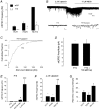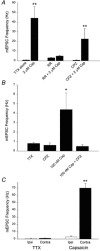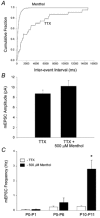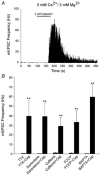Development of nociceptive synaptic inputs to the neonatal rat dorsal horn: glutamate release by capsaicin and menthol
- PMID: 12679376
- PMCID: PMC2342935
- DOI: 10.1113/jphysiol.2003.040451
Development of nociceptive synaptic inputs to the neonatal rat dorsal horn: glutamate release by capsaicin and menthol
Abstract
To study the postnatal development of nociceptive synaptic inputs in the superficial dorsal horn of the neonatal rat spinal cord, we examined the effect of capsaicin and menthol on glutamatergic mEPSCs in postnatal day (P) 0-1, P5-6 and P9-11 slices of spinal cord. Capsaicin (100 nM to 2 microM) increased the mEPSC frequency in a concentration-dependent manner at all ages tested, with a significant enhancement of the effect between P5 and P10. This effect was sensitive to vanilloid receptor (VR) antagonists. The elevation in mEPSC frequency occurred at concentrations of capsaicin (100 nM) that did not alter the distribution of mEPSC amplitudes and was abolished by a dorsal rhizotomy, demonstrating that capsaicin acts via presynaptic VR1 receptors localized on primary afferents. Menthol significantly increased the mEPSC frequency with a similar developmental pattern to capsaicin without consistently affecting mEPSC amplitude. The increase in mEPSC frequency following capsaicin did not depend on transmembrane calcium influx since it persisted in zero [Ca2+]o. The facilitation of spontaneous glutamate release by capsaicin was sufficient to evoke action potentials in neonatal dorsal horn neurons but was accompanied by a block of EPSCs evoked by electrical stimulation of the dorsal root. These results indicate that VR1-expressing nociceptive primary afferents form functional synaptic connections in the superficial dorsal horn from birth and that activation of the VR1 receptor increases spontaneous glutamate release via an undetermined mechanism. In addition, the data suggest that immature primary afferents express functional menthol receptors that are capable of modulating transmitter release. These results have important functional implications for infant pain processing.
Figures






References
-
- Baccei M, Bardoni R, Fitzgerald M. Capsaicin elicits glutamate release in the superficial dorsal horn of the neonatal rat spinal cord. International Association for the Study of Pain, 10th World Congress on Pain Abstracts. p.70 pp.
-
- Bajjalieh SM, Scheller RH. The biochemistry of neurotransmitter secretion. J Biol Chem. 1995;270:1971–1974. - PubMed
-
- Bennett DL, Averill S, Clary DO, Priestley JV, McMahon SB. Postnatal changes in the expression of the trkA high-affinity NGF receptor in primary sensory neurons. Eur J Neurosci. 1996;8:2204–2208. - PubMed
Publication types
MeSH terms
Substances
LinkOut - more resources
Full Text Sources
Research Materials
Miscellaneous

